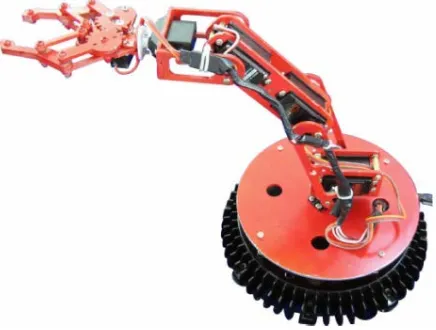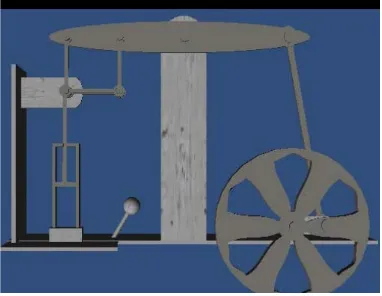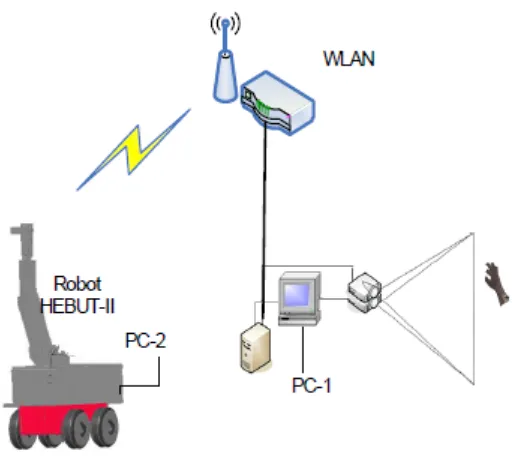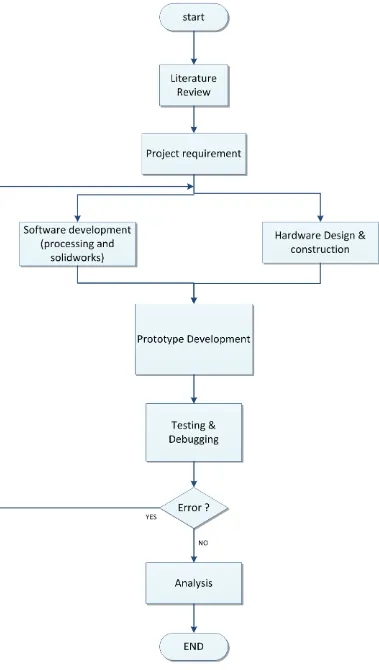PHONE VIRTUAL ENVIRONMENT FOR RC ASSISTIVE ROBOT
AHMED MUFTAH ALI ZARGOUN
A project report submitted in partial
Fulfillment of the requirement for the award of the Degree of Master of Electrical Engineering
Faculty of Electrical and Electronic Engineering Universiti Tun Hussein Onn Malaysia
v
ABSTRACT
vi
ABSTRAK
vii
TABLE OF CONTENTS
TITLE i
DECLARATION ii
DEDICATION iii
ACKNOWLEDGEMENT iv
ABSTRACT v
ABSTRAK vi
TABLE OF CONTENTS v
LIST OF FIGURE ix
LIST OF TABLE xi
CHAPTER1 INTRODUCTION 1
1.1 Problem statement 2
1.2 Aim and objective 2
1.3 Scope 3
1.3.1 Hardware 3
1.3.2 Software 3
CHAPTER2 LITERATURE REVIEW 4
2.1 Servo arm robot design 4
2.2 The IOIO board 6
2.3 Virtual reality based robots 8
CHAPTER3 RESEARCH METHODOLOGY 13
3.1 Project workflow 13
3.2 Hardware Design and Construction 15
3.2.1 G15 servo motor 17
3.2.2 G15 driver 17
3.2.3 Robot arm inverse kinematics 18
viii
3.3 Controller design 21
3.4 Monitor system design 21
3.5 Speed control 22
CHAPTER4 RESULTS, ANALYSIS AND DISCUSSION 24
4.1 Payload of the robot 24
4.2 Communication range and interferences 25
4.3 Work envelope 26
4.4 Joint analysis 27
CHAPTER5 CONCLUSION AND RECOMMENDATION 32
5.1 Conclusion 32
5.2 Recommendation 33
ix
LIST OF FIGURES
2.1 Six-servo robot arm 4
2.2 Robot arm complete assembly 5
2.3 The system startup diagram 6
2.4 Block Diagram of Complete System 7
2.5 Virtual reality simulation 8
2.6 The game simulation 10
2.7 Virtual robot workspace 11
2.8 Virtual reality robot teleoperation system 9
3.1 The project workflow 14
3.2 The system architecture 15
3.3 The assembled robot arm design 16
3.4 The G15 block diagram 17
3.5 G15 serial driver 17
3.6 The serial servo driver schematic 18 3.7 The x-z Plane of the robot 19 3.8 Force diagram of the robot arm 20 3.9 Controller design of the control mode 21
3.10 Monitor system design 22
3.11 The flowchart of making the phone model 23 4.1 Force diagram of the robot arm 23 4.2 The connection interferences 25 4.3 Work envelope of the robot arm 26 4.4 The part of moving the robot arm to specific
point
27
4.5 The shoulder joint actual and desired 28
x
xi
LIST OF TABLE
4.1 Six-servo robot arm 24
CHAPTER 1
INTRODUCTION
Robotic systems nowadays are all around us and interact in many aspects of our everyday lives. For example, many homeowners use robotic vacuums in their homes. Robotic components are used to assemble the cars that many of us drive. However, a push needed to make these systems more and more interactive with humans. Interaction with real people is a difficult task, and much more complex than the simple, monotonous behaviours most robots perform today. Assistive technologies such as those to help the elderly require a delicate, refined process, simplicity and easy visualization in order to gain more popularity.
In this project a smart phone controller will have a CAD model which has the same parameters as the designed RC servo robot arm, the robot arm will move as the CAD model move and vice versa.
The IOIO is a board that provides a host machine the capability of interfacing with external hardware over a variety of commonly used protocols. The original IOIO board has been specifically designed to work with Android devices. The IOIO board can be connected to its host over USB or Bluetooth, and provides a high-level Java API on the host side for using its I/O functions as if they were an integral part of the client[1].
2
Virtual reality is the digital-generated simulation of a two or three dimensional image or environment that can be interacted with in a seemingly real or physical way by a user using computer or any electronic devices.
Combination of IOIO board and Processing will be done to achieve the monitoring and controlling process. IOIO board for the I/O interface, such as digital input, digital output, analog read, analog write and I2C. Processing is an android game development kit will be used to design the CAD model.
1.1 Problem statement
Number of patients keeps increasing every year due to more disease nowadays. The duty of the nurse also keeps increasing. Patients who cannot move their arm need a nurse to feed them. Unfortunately nurse sometimes is very busy to serve all the patients in the hospital. This issue cannot be solved without help from other parties such as involvement of the assistive robot. Therefore, a robot is needed in order to assist the nurse serve the patients. However, the normal robot is complex and very difficult to control the movement, since more training is needed before operate this type of robot. On the other hand Smart phones nowadays are used almost by everyone. Therefore, in this study a combination of smart phone and assistive robot will be developed to overcome this problem. This assistive robot does not require the patients more than moving a finger to assist them.
1.2 Aim and objectives
The aim of this project is to make a user friendly smart phone application to monitor and control the robot arm. In order to achieve the aim there are three objectives need to be done.
• Design an RC assistive servo robot arm in a practical environment.
• Design a user friendly smart phone controller for the RC servo
3
• Monitor and control the assistive robot arm through the smart phone
application
1.3 Scope
The scopes of the project as outline below:
1.3.1 Hardw are:
• RC servo robot arm.
• Android IOIO board.
• 6 channels servo motor driver.
1.3.2 Softw are:
• Android SDK development tools.
• Processing Android for game development.
• SolidWorks for the robot arm design.
CHAPTER 2
LITERATURE REVIEW
This chapter presents the current navigation technologies with an overview of IR sensors detecting processing. The details in robot design is discussed in this chapter and followed by the details of the creating a virtual reality of the real robot.
2.1 Servo arm robot design
[image:12.595.212.430.569.734.2]In [1] six servo arm structure designed, it has 6-DOF robot arm movements. It uses three pieces of 13 kg torque metal gear, a 3.2 kg, for the first three joints because it will have a higher load compared with the rest of the joints, two pieces of 2.3 kg of servo for the joints closer to the end effector, and some sophisticated combination of aluminum alloy processing components. The robot arm is mainly 390 mm length, use 32-way controller to control the operation of arm action.
5
In [3] the robot arm joints are typically actuated by electrical motors. The servo motors were chosen, since the encoders are included which automatically provide feedback to the motors and adjust the position accordingly. However, the disadvantage stated of these motors is that the rotation range of these motors is less than 180˚ span, which greatly decreases the work space of the arm and the possible positions.
[image:13.595.197.440.256.614.2]The qualifications of servo motors were selected based on the maximum torque required by the structure and possible loads.
6
2.2 The IOIO board
[image:14.595.143.498.363.658.2]In [4] the IOIO Board is used as direct extension of the Android device. Therefore, the board used as the MicroBridge approach, it was connected to the device as USB host, but it did not featured a user programmable microcontroller CPU. The onboard PIC CPU has a fixed firmware. The idea was to control the boards IO ports directly via the Android host. In order to use the powerfulness Java API provided. With that API, it was easy to directly access the board’s general I/O pins or any dedicated communication pins for e.g. SPI, I2C and Serial communication. Internally, it also stacks upon the ADB protocol and a virtual TCP connection. To connect the Android host to NXT components, the IOIO approach is the most general one to connect any electrically interfaced hardware, actuator or sensor, to Android. The system implemented as shown in Figure 2.3.
7
In [5] a person operates the android device with an established connection to the IOIO board. A signal is generated against each button which represents specific movements. These signals are attend by a specific PIC on the IOIO board which is directly connected to the input manipulations in this data using different scaling factors through programming and controls the direction and speed of port of 89C51 microcontroller. This digital data is fed in a microcontroller, which performs several manipulations in this data using different scaling factors through programming and controls the direction and speed of motors which results in the motion of robotic arm.
Reception Reception
IOIO board IOIO board
µ controller µ controller
Drive circuit Drive circuit
Robotic arm movement Robotic arm
movement Android
Application
(connectivity via bluetooth) Android
Application
[image:15.595.127.511.277.557.2](connectivity via bluetooth)
8
2.3 Virtual reality based robots
In [6] the advantages of mechanics simulation based on game engine discusses, introduces the physics engine technology in detail and emphasizes on showing how to use the game engine to simulate mechanical devices.
[image:16.595.128.510.300.596.2]The virtual device can run very well. Still, it can’t interact with it in real time. So a necessary variety of interactive functions add to the model. Here's a switch design for the device. Users can hold it to turn on or turn off the machine at run time. Figure 2.5 shows the final simulation drawing. When the switch is turned on, the wheel will rotate. When it is turned off, the wheel will stop rotating.
9
In [7] the Karma physics engine was used to simulate interactions among solid objects such as crates, tires or bones, as well as different joints, motors or springs that make up mechanical objects. It provides physics modelling, rigidbody dynamics with constraints and collision detection.
The robot dynamics simulation is greatly simplified by the Unreal engine’s vehicle class which uses the Kama engine’s Car wheel Constraint joint A vehicle is made of a chassis, one or more wheels and the joints that connect the wheels to the chassis. The wheel rotates about its rolling or hinge axis; the chassis travels along the suspension direction and the wheels steer about the steering axis. The vehicle is driven by a motor whose output torque is provided by interpolating along its Torque-Spinspeed curve.
The proximity sensor modelling was modelled by the entity in Unreal has a vector representing its location as a triple: X-coordinate, Y-coordinate, and Z-coordinate. The Trace function will trace a line through the environment and return a reference to the first object the line collides with being it a wall, another entity, or some other obstruction. The location data returned can be manipulated in much the same way sonar data is.
10
In[8] The Open Dynamics Engine (ODE) used which is an open source, high performance library for simulating rigid body dynamics. It is a fully featured, stable, mature and independent platform with an easy to use C/C++ API. It has advanced joint types and integrated collision detection with friction.
ODE is useful for simulating vehicles, objects in virtual reality environments and virtual creatures. It is currently used in many computer games, 3D authoring tools and simulation tools.
The graphical model consists of a set of 3D objects modelled using 3D Studio and imported into the XVR development environment where they are managed using the XVR scene graph.
The modelled objects are: the billiard table, the cue, the billiard balls and the skittles. An example of billiards with five skittles has been implemented.
[image:18.595.114.526.464.710.2]XVR provides classes for the lighting, shading and observation point (virtual camera) management; in addition, it allows the user to superimpose 2D text onto the scene and this functionality is used in order to provide the user with messages about the system conditions, working modality and error states. Figure 2.6 shows the game simulation of the billiard.
11
In [9] a research into an interface between industry robots and Virtual Reality systems and creates a virtual robot for robot arm simulation, control language conversion, physical communication, robot networking and teleportation control. The main objective of this project was to combine VR and robot technology for system testing, to establish VR based simulation workshop for defining and checking robot arm movement trajectory, in order to eliminate the chance of potential collisions.
[image:19.595.115.542.277.600.2]A robot executes the defined task in the workspace by replicating operator’s movements in the virtual workspace.
12
[image:20.595.201.457.239.469.2]In [10] the virtual reality teleoperation system was made up of data glove and stereoscopic glasses combine together with virtual reality software. The virtual robot was controlled by an operator using a data glove to complete task, the virtual robot is the agent of real robot, and thus the control to the real robot is carried out by controlling the virtual robot. Every movement of the virtual robot is transmitted to the real robot, so that the virtual robot and the real robot always move synchronously.
Figure 2.8: Virtual reality robot teleoperation system
CHAPTER 3
RESEARCH METHODOLOGY
This chapter describes the methodology employed into account for this project. It begins with analysing the project workflow, followed by hardware and software system design.
3.1 Project workflow
This project involves both software development and hardware design and construction, in this project the designed arm robot will react according to the input from the android phone in order to achieve the objectives, the project workflow is shown in Figure 3.1.
There are several tools, which have to be mastered in order to produce the complete system. This comprises SolidWorks and Processing use the Java programming language in the software development phase. The IOIO board has been applied as a main controller to run the system as an embedded system, and integrate the android application that has been designed with the hardware design.
14
15
Figure 3.2: The system architecture
The system architecture of the project shown in Figure 3.2, the robot arm will move according to the user’s phone model, the process of controlling the motor will be all through the Android API. Therefore, the faster the phone processor the faster process and response, the higher the phone memory the more complex system can be done.
3.2 Hardw are Design and Construction
16
[image:24.595.139.526.135.656.2]designed using SolidWorks and created using 3D printer machine. The material has been used is ABS.
17
3.2.1 G15 servo motor
[image:25.595.127.514.257.428.2]G15 servo motor is a smart half-duplex serial servo which incorporates gear reducer. G15 provides 360o endless turn control with resolution up to 0.33o. It allows daisy chain connection to multiple servos to create a servo network on a single line and comes with over temperature and over torque protection to prevent damage to the servo. The block diagram of the G15 servo motor shown in Figure 3.4.
Figure 3.4: The G15 block diagram
3.2.2 G15 driver
It’s a Half-Duplex Communication converter board. It converts UART duplex communication to half-duplex single line communication required to move the servo motor the desired position or read the actual position of the servomotor. Figure 3.5 shows the serial servo motor driver used.
[image:25.595.250.387.620.747.2]18
[image:26.595.130.511.158.432.2]The circuit shown in Figure 3.6 converts the UART communication lines to G15 DATA line. The UART-TX and UART-RX shown in the circuit is connected to controller’s UART pin of TX and RX respectively.
Figure 3.6: The serial servo driver circuit
3.2.3 Robot arm inverse kinematics
The position given by using the Cartesian coordinate system. Each motor will have a specific function: the motor for the base rotation position the final element in the y axis, the motors for the forearm and arm positions the final element in the x and z axis. Therefore, x-z plane was used to simplify calculation of the joint angles (θ1 and
19
Figure 3.7: xz Plane.
Using trigonometric relations, the joint angles are determined, as follows.
𝜃0 =𝑎𝑟𝑐𝑇𝑎𝑛 �𝑦𝑥� (3.1)
𝜃1 =𝑎𝑟𝑐𝑇𝑎𝑛 �𝑧𝑥�+𝑎𝑟𝑐𝐶𝑜𝑠 �𝑎
2−𝑏2+𝑥2+𝑧2
2×𝑎×√𝑥2+𝑧2� (3.2)
𝜃2 = 180°− 𝑎𝑟𝑐𝐶𝑜𝑠 �𝑎
2+𝑏2−𝑥2−𝑧2
2×𝑎×𝑏 � (3.3)
The base rotation is going to use θ0 and the two motors going to use θ1 and θ2
as shown in Figure 3.7.
3.2.4 Payload
[image:27.595.184.455.71.273.2] [image:27.595.166.482.357.498.2]20
Figure 3.8: Force diagram of the robot arm
(
)
(
)
( )
AAB a AB motorC BC AB b BC AB motorB CD BC AB c CD BC AB A M l W l W l l W l l W l l l W l l l L M + − − + − + − + + − + + − =
∑
2 2 2 (3.4)(
)
( )
(
AB BC CD)
A AB a AB motorC BC AB b BC AB motorB CD BC AB c l l l M l W l W l l W l l W l l l W L + + + − − + − + − + + −
= 2 2
2
(3.5)
Where Wa (wight of the first link AB) = 0.05 Kg
Wb (wight of the second link BC) = 0.05 Kg
Wc (wight of the third link CD) = 0.095 Kg
Wmotor (wight of the motor) = 0.063Kg
lAB (lenght of AB) = 0.24 m
lBC (lenght of BC) = 0.24 m
lCD (lenght of CD) = 0.01 m
MA (tourqe of the motor) = 24 Kg.cm = 2.35 N.m
21
3.3 Controller design
The controller has been implemented on the IOIO board which contains PIC24FJ256. This microcontroller is the richest peripherals PIC controller, it has 24 PWM pin, 3 I2C communications and 16 analog inputs and a lot more.
[image:29.595.127.522.365.469.2]The controller of this project is as shown in Figure 3.8. When the user move the phone model processing will calculate the angle of each joint, the angel value will be sent through Bluetooth communication to the microcontroller, the microcontroller transmitter (TX) the desired position of the serial driver which convert that Tx-UART data to signal line data, then sent it to the G15 servo motor. The G15 servo motor will respond to the received DATA and return another line of data which tells the system that position is determined.
Figure 3.9: Controller design of the control mode.
3.4 Monitor system design
One of the objectives of this project is to monitor and control the movement of the robot, the monitor system works as follows. When there is a force or trajectory movement in progress on the real model, the user won’t be able interfere the movement of the robot from the phone. Therefore, the phone model will be in monitor mode. There is a button provided to the user in order to stop any trajectory movement and make the phone model go to control mode.
22
Figure 3.10: Monitor system design
3.5 The phone model design
23
CHAPTER 4
RESULTS, ANALYSIS AND DISCUSSION
In this chapter there are two tests to be carried out to analyse the developed system performance; analysis on payload, communication range and work envelop have been done.
4.1 Payload of the robot
By performing the sum of the moments around point A, Equation (3.4), since the MA
[image:32.595.105.531.541.649.2]is known the equation to calculate the maximum load became as in Equation (3.5). Based on the analysis and calculations have been done the maximum load of the robot arm is 5.25 Kg. It’s more than enough for feeding and some basic light duties.
Table 4.1: The load test
The load value The state
0.6 Kg Moving smoothly
1.2 Kg Moving smoothly
1.8 Kg Moving smoothly
34
REFERENCES
[1-18]
1. Monk, S., Making Android Accessories with IOIO. 2012: O'Reilly. 2. Reas, C. and B. Fry, Getting Started with Processing. 2010: O'Reilly.
3. Elfasakhany, A., Design and Development of a Competitive Low-Cost Robot Arm with Four Degrees of Freedom. Modern Mechanical Engineering, 2011. 01(02): p. 47-55.
4. Gobel, S., et al., Using the Android Platform to control Robots. Kassel University Germany.[Online]. Available: www. innoc. at/fileadmin/user_upload/_temp_/RiE/.../65. pdf.
5. Ali, Z.A., et al., Android Operated Robotic Arm. 2014.
6. Wenfeng, H., Q. Zhouqing, and Z. Xiaoyuan. A New Approach of Mechanics Simulation Based on Game Engine. in Computational Sciences and Optimization (CSO), 2012 Fifth International Joint Conference on. 2012. 7. Lewis, J., et al. Simulating visual impairments using the Unreal Engine 3
game engine. in Serious Games and Applications for Health (SeGAH), 2011 IEEE 1st International Conference on. 2011.
8. De Paolis, L.T., M. Pulimeno, and G. Aloisio. An Interactive and Immersive 3D Game Simulation Provided with Force Feedback. in Advances in Computer-Human Interaction, 2008 First International Conference on. 2008. 9. Xu, Z., et al. Virtual Reality Based Robot Graphic Simulation and Virtual
Manufacturing System. 1997. The 1997 Chinese Automation Conference in the UK (CACUK’97).
10. Guangming, Y., L. Xiaoling, and Z. Minglu. Design of Mending Robot Based on Hearing and Virtual Reality. in Computer Science and Software Engineering, 2008 International Conference on. 2008.
11. Buttussi, F., et al., Evaluation of a 3D serious game for advanced life support retraining. Int J Med Inform, 2013. 82(9): p. 798-809.
12. Cashion, J., C. Wingrave, and J.J. LaViola, Jr., Dense and dynamic 3D selection for game-based virtual environments. IEEE Trans Vis Comput Graph, 2012. 18(4): p. 634-42.
13. Cheah, T.C.S. and K.W. Ng. A practical implementation of a 3D game engine. in Computer Graphics, Imaging and Vision: New Trends, 2005. International Conference on. 2005.
14. de la Croix, A. and J. Skelton, The simulation game: an analysis of interactions between students and simulated patients. Med Educ, 2013. 47(1): p. 49-58.
35
16. Lamiable, A., et al., An algorithmic game-theory approach for coarse-grain prediction of RNA 3D structure. IEEE/ACM Trans Comput Biol Bioinform, 2013. 10(1): p. 193-9.
17. Muehl, W. and J. Novak, Game development essentials : game simulation development. 2008, Clifton Park, NY: Thomson / Delmar Learning. xxvii, 242 p.









